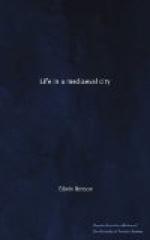The Chancel was the most sacred part of the church, for there was the principal or high altar. In the Chancel were the stalls or seats of the clergy and officials. The actual seats could be turned up when the occupants wished to stand. Standing for long periods was made less irksome in that the underside of each seat was made with a projecting ledge, which gave some support. It is thoroughly characteristic of the age that this very human device should have existed, and, secondly, that these ledges were carved and ornamented. These misericords, as they are called, were usually curiously, even grotesquely carved. Some of these carvings were founded on natural objects, some were grotesque heads, others represented subjects with man and animals. There were pews for the nobility, but, apart from the few old and weak people who used the rough bench or two in the body of the church, or the stone bench that ran along the walls, the general public stood during the services.
Wealthy parishioners left money to the parochial clergy and for the fabric of the church: they generally wished to be buried at some particular place within their parish church. Such distinguished men as Nicholas Blackburn, merchant of York, were commemorated at times in their parish churches by means of stained-glass windows. The portraits of Nicholas and his son and their wives appear in the east window of All Saints’, North Street; his arms also are to be seen in this window.
D. YORK AS A PORT
The Ouse was tidal and navigable right up to York. Trade, especially in woollen goods, was carried on in the fifteenth century by river and sea directly between York and ports on the west coasts of the continent and, especially, Baltic ports. On arriving at York the boats stopped at the quays, adjacent to which were warehouses, just below Ouse Bridge.
The sea-going boats were not large. They were usually one-masted sailing ships, built of wood; they had high prows and sterns, with a capacious hold between. Some of them were built in York.
Their trade was such that some of the York merchants, for example the wealthy Howme family, had establishments in foreign ports. The Howmes had property in Calais.
The regulation of the waterways in and near the city was vested in the Corporation. Matters pertaining to navigation and shipping were adjudged by an Admiralty Court under the King’s Admiral, whose jurisdiction extended from the Thames to the northern ports.
FOOTNOTES:
[1] Derived from Latin foris=outside, without (the city).
[2] A “church” that was in a parish, but was not the parish church, was called a chapel. The parish church was the principal and parent church of all within the parish.
[3] Compare the Tollbooth, Edinburgh, and the Tolhouse, Yarmouth.
[4] Cf. French manger.




